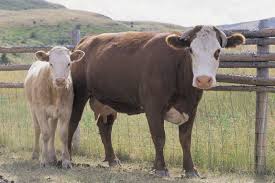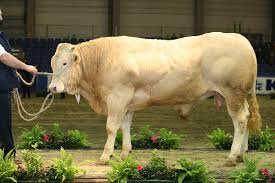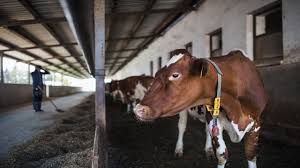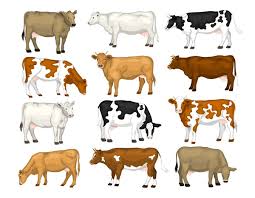Different breeds of cattle play a crucial role in agriculture and livestock production worldwide. They are primarily raised for various purposes, including meat, milk, leather, and draft work.
Understanding the characteristics and differences among these breeds is essential for farmers, ranchers, and consumers alike, as it influences decisions related to breeding, feeding, and management practices.
Each breed has its unique traits, making them suitable for specific climates, environments, and agricultural systems.
Cattle can be broadly categorized into two main types: beef cattle and dairy cattle. Beef cattle, such as Angus, Hereford, and Charolais, are bred primarily for meat production.
These breeds are known for their muscular build, growth rates, and feed efficiency, which make them economically viable for beef production.
For instance, Angus cattle are renowned for their high-quality marbled beef, while Charolais cattle are appreciated for their rapid growth and lean meat.
On the other hand, dairy cattle breeds, such as Holstein, Jersey, and Guernsey, are specifically selected for milk production. Holsteins, characterized by their distinctive black-and-white markings, are the most popular dairy breed globally due to their high milk yield. Jerseys, smaller in size, are known for producing milk with a higher butterfat content, making them valuable for cheese and butter production.
Each breed’s milking characteristics, temperament, and adaptability to environmental conditions vary, allowing farmers to choose breeds that align with their operational goals.
Apart from beef and dairy classifications, there are also dual-purpose breeds, which can be raised for both meat and milk. Breeds like the Simmental and Milking Shorthorn are examples of dual-purpose cattle that offer flexibility in farming operations.
These breeds typically exhibit good growth rates and can produce sufficient milk for dairy needs, making them an attractive option for mixed farming systems.
In addition to production traits, other characteristics, such as size, color, and temperament, can vary significantly among breeds. Some breeds, like the Brahman, are known for their heat tolerance and adaptability to harsh environments, making them ideal for tropical regions.
Others, like the British Blue, are recognized for their calm temperament and ease of handling, which can be beneficial in a farming setting.
Furthermore, the genetic diversity among cattle breeds contributes to their resilience against diseases and changing environmental conditions.
By maintaining a variety of breeds, farmers can ensure the sustainability of their herds, adapting to challenges such as climate change and market demands.
The preservation of indigenous breeds, which may have unique traits suited to local environments, is also vital for maintaining biodiversity and food security.
Importance of Cattle Breeds in Agriculture

Cattle breeds are vital for various agricultural functions, providing essential resources and contributing to the overall efficiency of farming practices:
1. Genetic Diversity: Different cattle breeds offer genetic diversity, which is crucial for breeding programs. This diversity allows farmers to select traits that enhance productivity, disease resistance, and adaptability to local conditions.
2. Adaptation to Environments: Various breeds are suited to specific climates and geographical areas. For example, some breeds thrive in hot, arid regions, while others are better suited to cooler climates, ensuring efficient farming across diverse environments.
3. Productivity: Cattle breeds are selected based on their productivity in terms of milk and meat production. High-yielding breeds can significantly increase farm outputs, supporting food security and economic growth.
4. Economic Value: The choice of cattle breed can influence profitability. Specialized breeds can provide higher quality products, such as premium beef or milk, which can command better market prices.
5. Sustainability: Selecting appropriate cattle breeds can enhance sustainability. Breeds that require less feed or are more resistant to diseases reduce the need for chemical inputs, promoting environmentally friendly farming practices.
Classification of Cattle Breeds
Cattle breeds can be classified based on various criteria, including their primary purpose, geographic origin, and physical characteristics. The main classifications include:
1. Based on Purpose:
i. Dairy Breeds: Breeds primarily raised for milk production, such as Holstein and Jersey, known for high milk yields and quality.
ii. Beef Breeds: Breeds raised for meat production, such as Angus and Hereford, valued for their growth rates and meat quality.
iii. Dual-Purpose Breeds: Breeds that provide both milk and meat, such as Milking Shorthorn and Simmental, offering versatility for farmers.
2. Based on Geographic Origin:
i. Bos taurus: Domestic cattle breeds found primarily in temperate regions, known for high productivity and adaptability to farming practices.
ii. Bos indicus: Zebu cattle, adapted to tropical and subtropical climates, characterized by their humped back and heat tolerance.
3. Based on Physical Characteristics:
i. Color Patterns: Breeds can also be classified by their coat colors, such as solid, brindle, or speckled patterns.
ii. Body Size and Shape: Some breeds are large and muscular, ideal for beef production, while others are smaller and more agile, suited for different agricultural tasks.
Read Also: 12 Medicinal Health Benefits of Alangium chinense (Chinese Alangium)
Characteristics of Beef Cattle Breeds

Beef cattle breeds possess specific traits that make them suitable for meat production, influencing their performance and economic viability:
1. Growth Rate: Beef breeds are typically selected for their ability to grow quickly. Faster growth rates allow for shorter production cycles and increased profitability for farmers.
2. Feed Efficiency: Many beef cattle breeds are known for their feed conversion efficiency, meaning they can convert feed into body weight effectively. This trait reduces feeding costs and increases profit margins.
3. Meat Quality: Beef breeds often possess desirable meat characteristics, such as marbling and tenderness, which are crucial for consumer preference and market demand. Breeds like Angus are renowned for their high-quality beef.
4. Adaptability: Some beef breeds are specifically bred for adaptability to various environmental conditions, such as heat tolerance or resistance to diseases, ensuring consistent production regardless of location.
5. Reproductive Performance: Successful beef production relies on effective breeding programs. Many beef cattle breeds exhibit strong reproductive traits, including fertility and calving ease, essential for maintaining herd productivity.
Characteristics of Dairy Cattle Breeds
Dairy cattle breeds are specifically developed for milk production and have distinct traits that contribute to their efficiency:
1. High Milk Yield: Dairy breeds, such as Holstein and Jersey, are known for their ability to produce large quantities of milk, making them ideal for commercial dairy farming.
2. Milk Composition: Different dairy breeds produce milk with varying fat and protein content. For example, Jerseys typically produce milk with higher butterfat, beneficial for cheese and butter production.
3. Temperament: Many dairy breeds are known for their docile nature, making them easier to handle and manage in a farm setting.
4. Physical Characteristics: Dairy cattle often have a leaner build compared to beef cattle, with long bodies and large udders to accommodate milk production.
5. Longevity and Productivity: Many dairy breeds have been selectively bred for long productive lives, allowing them to remain in the herd and continue to produce milk for several years.
Dual-Purpose Cattle Breeds
Dual-purpose breeds are valued for their ability to produce both milk and meat, making them versatile in agricultural settings:
1. Balanced Traits: Breeds such as Simmental and Devon provide a good balance of milk production and meat quality, making them suitable for mixed farming operations.
2. Efficient Feed Conversion: Dual-purpose breeds tend to convert feed into both milk and meat effectively, optimizing resources and reducing waste.
3. Economic Viability: Farmers benefit from the flexibility of dual-purpose breeds, as they can market both milk and beef, increasing overall profitability.
4. Hardiness: Many dual-purpose breeds are hardy and adaptable to various environments, making them resilient under different farming conditions.
5. Lower Production Costs: By raising dual-purpose breeds, farmers can reduce costs associated with maintaining separate herds for milk and meat production.
Adaptability of Cattle Breeds to Different Environments
Cattle breeds exhibit various levels of adaptability, impacting their performance in diverse environmental conditions:
1. Climate Resilience: Certain breeds, like Brahman, are well-suited to hot, humid climates due to their heat tolerance and resistance to diseases prevalent in tropical regions.
2. Grazing Preferences: Some breeds thrive in extensive grazing systems, while others are better suited for confined feeding operations. For instance, Angus breeds are adaptable to pasture-based systems.
3. Nutritional Needs: Different breeds have varying dietary requirements, with some able to thrive on lower-quality forage. Breeds like Hereford can efficiently utilize roughage.
4. Disease Resistance: Adaptable breeds often possess genetic traits that provide resistance to specific diseases, making them more sustainable in challenging environments.
5. Performance in Diverse Systems: The ability of certain breeds to perform well under varying management systems, such as extensive or intensive farming, is crucial for successful cattle farming.
Read Also: 10 Medicinal Health Benefits of Garcinia Atroviridis (Asam Gelugor)
Differences in Size and Weight Among Cattle Breeds

Cattle breeds differ significantly in size and weight, influencing their utility and management:
1. Size Variation: Breeds like Holsteins can weigh between 1,500 to 2,200 pounds, while smaller breeds like Dexter may weigh only 600 to 1,200 pounds.
2. Growth Rate: Some breeds, such as Charolais, are known for their rapid growth rates, making them ideal for meat production, whereas dairy breeds may have slower growth.
3. Frame Size: Larger-framed breeds typically produce more meat, while smaller-framed breeds may be more efficient in milk production relative to their size.
4. Calving Ease: Smaller breeds often have an advantage in calving ease, reducing the risk of complications during birth, which can be a critical factor for farmers.
5. Market Preference: The size and weight of cattle influence market demand, with consumers often preferring specific weights and sizes for beef production.
Color and Coat Variations in Cattle Breeds
Cattle breeds exhibit a wide range of color and coat variations, which can influence their management and marketability:
1. Color Patterns: Cattle can be solid, speckled, or patterned, with common colors including black, white, brown, and red. For example, Holsteins are predominantly black and white, while Angus are typically solid black.
2. Coat Type: Coat types vary among breeds; some have short, sleek coats suited for hot climates, while others have longer, thicker coats that provide insulation in colder environments.
3. Genetic Influence: Color and coat variations are influenced by genetics, with specific genes determining the presence of certain colors and patterns in different breeds.
4. Market Preferences: Certain colors may be preferred in specific markets, impacting the economic viability of cattle farming. For instance, red and white Herefords can be favored for their unique appearance.
5. Heat Tolerance: Darker coats can absorb more heat, affecting a breed’s performance in hot climates, while lighter-colored coats may offer better heat tolerance.
Behavioral Traits of Different Cattle Breeds
Behavioral traits vary significantly among cattle breeds, influencing their management and interaction with handlers:
1. Temperament: Some breeds are known for their calm demeanor, such as Jersey and Hereford, while others may exhibit more aggressive or skittish behavior, like some dairy breeds.
2. Social Structure: Cattle are social animals, and breed-specific traits can influence herd dynamics. Breeds like Angus tend to form strong social bonds, while others may be more solitary.
3. Trainability: The ease of training can vary; breeds such as Holsteins often respond well to training and handling, making them suitable for intensive farming systems.
4. Grazing Behavior: Some breeds exhibit different grazing habits, with certain breeds preferring to graze in herds while others may be more independent in their feeding behavior.
5. Responses to Stress: Behavioral traits can affect how cattle respond to stressors, including environmental changes or handling practices. Some breeds are more resilient, while others may show signs of stress more readily.
Economic Importance of Cattle Breeds
The economic importance of cattle breeds is significant in agricultural systems, contributing to livelihoods and food production:
1. Meat Production: Cattle breeds are a major source of meat, with specific breeds like Angus and Charolais being highly valued for their meat quality and yield.
2. Milk Production: Dairy breeds, such as Holsteins and Jerseys, are critical for milk production, contributing to dairy industries and providing a source of income for farmers.
3. By-products: Cattle also provide valuable by-products, including leather, which contributes to the economy beyond just meat and milk production.
4. Employment Opportunities: The cattle industry creates jobs in farming, processing, and distribution, significantly impacting rural economies and providing livelihoods for many.
5. Global Trade: Cattle breeds play a crucial role in international trade, with countries exporting and importing cattle and beef products, thus influencing global agricultural markets.
Choosing the Right Cattle Breed for Your Needs
Selecting the right cattle breed is essential for optimizing productivity and profitability:
1. Assess Your Goals: Determine whether your focus is on milk production, meat production, or dual-purpose farming, as different breeds excel in these areas.
2. Consider Environmental Conditions: Evaluate the climate and available resources, choosing breeds that are well-suited to your specific environmental conditions.
3. Economic Factors: Consider market demands and economic viability, selecting breeds that align with consumer preferences and offer good returns on investment.
4. Management Practices: Choose breeds that match your management style and resources, ensuring you can meet their needs for nutrition, health, and care.
5. Long-term Planning: Think about long-term goals, including breeding and herd development, to ensure that your chosen breed will contribute to your farming objectives over time.
Do you have any questions, suggestions, or contributions? If so, please feel free to use the comment box below to share your thoughts. We also encourage you to kindly share this information with others who might benefit from it. Since we can’t reach everyone at once, we truly appreciate your help in spreading the word. Thank you so much for your support and for sharing!
Read Also: Six Health Benefits of Sugarcane Juice
Frequently Asked Questions
We will update this section soon.

